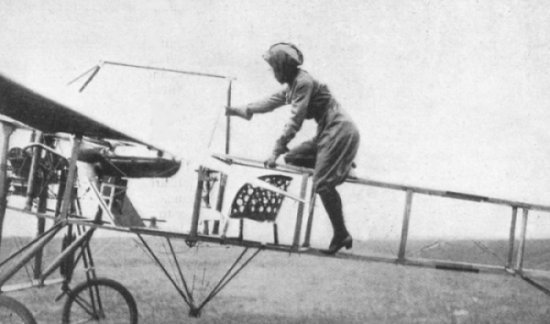Four Women on Hempstead Plains
Today, four women gravitate skyward. The University of Houston's College of Engineering presents this series about the machines that make our civilization run, and the people whose ingenuity created them.
In 1910, the new flying machines began converging on Long Island, about twenty miles east of Manhattan. Nassau County's Hempstead Plains was ideal for flying. Aerodromes and dirigible masts were sprouting. Later, Lindbergh took off for France here, as did Wrong-Way Corrigan, who followed in his slipstream.
But now the Wright Brothers, just back from their triumphal Europe trip, were setting up shop here. So was their fierce competitor, Glenn Curtiss. A recent book about the Hempstead Plains, calls it The Cradle of Aviation.
Four women came to Nassau County's flying fields in 1910 and 1911: first Blanche Scott and Bessica Raiche, then Matilde Moisant and Harriet Quimby. Historian Eileen Lebow tells their stories:
At 19, Scott had driven a woman journalist in a looping six-thousand-mile automobile trip across America — a publicity stunt for the Willys Company. Glenn Curtiss rewarded her with an airplane ride. She loved it and badgered him into teaching her to fly.
Curtiss only let her taxi around the airfield with a governor on the engine. But, in September, 1910, a gust of air made her airborne. Scott circled and landed, thus becoming the first American woman to fly.
Bessica Raiche, on the other hand, was a 34-year-old doctor and married. She and her husband built their own Curtiss-style airplane, and she soloed in it a few days after Scott. Though she shares credit as the first American woman to fly, she got out of the business. She moved to California and, in 1923, served as president of the Orange County Medical Association.
Scott, on the other hand, became a famous flyer. She miraculously survived during her six years of barnstorming, although she liked to boast that she had 42 mended bones to show for it.
The oldest of the four, Harriet Quimby, was a writer for Leslie's Illustrated Weekly. And her friend Moisant was the sister of an important pioneer airplane builder. They both learned to fly in Moisant airplanes. Harriet Quimby is famous for her style and pizzazz, for being the first woman to fly the English Channel — and for falling to her death at a Boston air show.
Moisant lost her brother in a Louisiana air show. She eventually gave up flying, to live to an age of 85. But, of the four, the greatest pilot was probably Blanche Scott. Billed as The Flying Tomboy, she did extraordinary feats of raw daring. She was flying with Quimby at Boston the day Quimby died. Scott was barely able to land afterward, with crowds milling about the field below.
But she lived. And in 1948 the great test pilot Chuck Yeager took her for a ride in a new jet airplane, soon after he'd broken the sound barrier in one. Thus Blanche Scott, first American woman to fly, was also first to fly in a jet. Think of it — what a remarkable reminder of just how rapidly early flight came of age!
I'm John Lienhard, at the University of Houston, where we're interested in the way inventive minds work.
(Theme music)
G. C. Dade and F. Strnad, Picture History of Aviation on Long Island: 1908-1938. New York: Dover Publications, Inc., 1989.
E. F. Lebow, Before Amelia. Washington, D.C.: Brassey's Inc., 2002, Chapters 7, 8, and 9.
For more on early women fliers, see: J. H. Lienhard, Inventing Modern: Growing up with X-Rays, Skyscrapers, and Tailfins. New York: Oxford University Press, August, 2003, Chapter 10.

Harriet Quimby mounting her Moisant monoplane
( From The American Review of Reviews, 1911.)